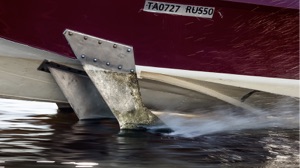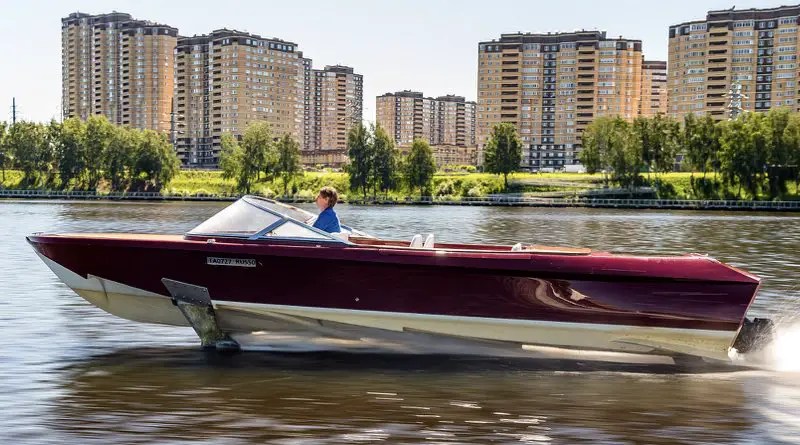Classic look hydrofoiling electric boat debuts in Moscow
A team in Russia has developed this sleek hydrofoiling electric boat with a retro-tech classic runabout look, both inside and out.
The boat is called the Molniya – Russian for ‘lightning’ – and uses fixed surface piercing (SP) foils rather than the retractable inverted-T fully submerged (FS) type on boats like the Candela 7.
The Molniya prototype was built by Artem Markov and a small team he assembled in Moscow. Markov is a graduate of the Moscow Automobile and Road Construction Institute, where he was part of their Formula MADI electric car racing team that competed against other universities from around the world.
Hydrofoiling electric boat idea started in 2016
Like many other electric boat developers he is also a long time sailor and says “I have never been able to understand what is the beauty of going on motor boats with a lot of vibration and noise. So, I decided I wanted to find a way to transfer the silence and comfort of a sailing yacht to a boat. The idea came to me in 2016, and from that moment I started working on the project.”
He is a big fan of the work that the team at Candela has been doing, and is well versed in their reasonings of why hydrofoiling is the way to reduce drag and increase efficiency and comfort. So he knew foiling was the way to go and began to design his dream boat.

It is one thing to know exactly what one wants, but budget realities quite often make inventors adapt. So he found a classic fibreglass-and-aluminum hull and went to work redesigning and converting it. The team had to strengthen and reinforce the hull to handle the stresses from the front foils. At the stern of the boat they designed protruding half-wings that would help lift the boat onto those front SP foils as it accelerated.
80kW motor mounted to stern drive unit
 For propulsion the decision was made to adapt the runabout’s stern drive (or Z-drive or Inboard/Outboard, depending on where you live). Using the knowledge and experience from designing and building electric racing cars, he commissioned an 80kW • 100HP motor to tie in with the existing lower unit. It’s the same concept used by AQAForce in Germany and Denmark’s EPTechnologies.
For propulsion the decision was made to adapt the runabout’s stern drive (or Z-drive or Inboard/Outboard, depending on where you live). Using the knowledge and experience from designing and building electric racing cars, he commissioned an 80kW • 100HP motor to tie in with the existing lower unit. It’s the same concept used by AQAForce in Germany and Denmark’s EPTechnologies.
That gives the 8.9 m • 29 ft boat a cruising speed of about 20 kts • 37 km/h and maximum speed of 36 kts • 66km/h. As for range, the Molniya can go for 135 Nautical miles at 5 kts, 17 Nm at 25 kts and 20 Nm at the top speed.
For the battery, they have taken stock lithium-ion cells and developed the modules themselves. The size is 160kW and there are some creative and useful ideas incorporated into the charging and battery management systems. One is the ability to connect a warning system to a GPS route so if you are driving at a speed that is taking you beyond range of getting back to shore the motor will automatically slow down. When you do get back, a full 0-100% charge takes 3.5 hours and you can check status through SMS.

One of the intriguing things about the Molniya is that all of the electric boat technology has been incorporated into a striking overall retro look. The dashboard looks like it might have been taken from a 1950s luxury car catalogue, but of course the actual meters are all digital. The interior of the entire boat harkens back to an earlier day, appearing ready to whisk 6 passengers off to a swing era supper club.
From prototype to production
Having built and tested the prototype from an existing hull, the goal of Markov and the team is to move to production mode and use the materials he always envisioned in his dream boat. While the aluminum and fibreglass of the original have been useful for testing, speed and range will benefit from materials like much lighter carbon-kevlar.

The adapted stern drive was useful for proving the hydrofoiling electric boat concept, but all of the designers and engineers are keen to see the improved efficiency they will get from a motor, drive and battery system they have designed from scratch for the Molniya. As for the foils themselves, the production model will use lighter, thinner composites instead of stainless steel.
Obviously the spring and summer of 2020 has not provided the best opportunities to introduce the prototype at boat shows and stir up interest with consumers, the trade or investors. It seems, though that the Molniya is the type of boat that should appeal to peopl looking for the same thing Artem wanted for himself: a classic motor boat experience but one that is quiet, odour free…and smooth sailing.
You can find out more on the Molniya website, lightning-foil.com.
Exciting things are happening every day in electric boats and boating.
Subscribe to the Plugboats newsletter so you don’t miss a thing!
Follow Plugboats on »» facebook, »» twitter »» Instagram »» Linkedin


